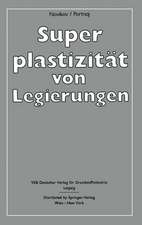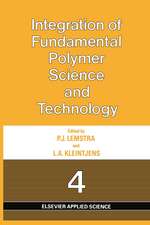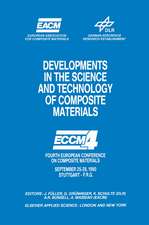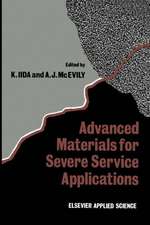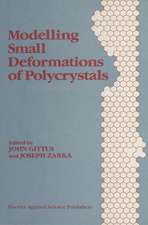Biological Adhesive Systems: From Nature to Technical and Medical Application
Editat de Janek Byern, Ingo Grunwalden Limba Engleză Hardback – 26 noi 2010
| Toate formatele și edițiile | Preț | Express |
|---|---|---|
| Paperback (1) | 795.27 lei 38-44 zile | |
| SPRINGER VIENNA – 22 aug 2016 | 795.27 lei 38-44 zile | |
| Hardback (1) | 827.07 lei 38-44 zile | |
| SPRINGER VIENNA – 26 noi 2010 | 827.07 lei 38-44 zile |
Preț: 827.07 lei
Preț vechi: 1088.26 lei
-24% Nou
Puncte Express: 1241
Preț estimativ în valută:
158.28€ • 171.87$ • 132.95£
158.28€ • 171.87$ • 132.95£
Carte tipărită la comandă
Livrare economică 19-25 aprilie
Preluare comenzi: 021 569.72.76
Specificații
ISBN-13: 9783709101414
ISBN-10: 3709101417
Pagini: 350
Ilustrații: XI, 305 p.
Greutate: 1.14 kg
Ediția:2010
Editura: SPRINGER VIENNA
Colecția Springer
Locul publicării:Vienna, Austria
ISBN-10: 3709101417
Pagini: 350
Ilustrații: XI, 305 p.
Greutate: 1.14 kg
Ediția:2010
Editura: SPRINGER VIENNA
Colecția Springer
Locul publicării:Vienna, Austria
Public țintă
ResearchDescriere
J. Herbert Waite Like many graduate students before and after me I was There are so many species about which nothing is known, mesmerized by a proposition expressed years earlier by and the curse of not knowing is apathy. Krogh (1929) – namely that “for many problems there is Bioadhesion is the adaptation featured in this book, an animal on which it can be most conveniently studied”. and biology has many adhesive practitioners. Indeed, This opinion became known as the August Krogh Prin- every living organism is adhesively assembled in the ciple and remains much discussed to this day, particu- most exquisite way. Clearly, speci? c adhesion needs to larly among comparative physiologists (Krebs, 1975). be distinguished from the opportunistic variety. I think The words “problems” and “animal” are key because of speci? c adhesion as the adhesion between cells in the they highlight the two fundamental and complementary same tissue, whereas opportunistic adhesion might be the foci of biological research: (1) expertise about an animal adhesion between pathogenic microbes and the urinary (zoo-centric), which is mostly observational and (2) a tract, or between a slug and the garden path. If oppor- mechanistic analysis of some problem in the animal’s life nistic bioadhesion is our theme, then there are still many history or physiology (problem-centric), which is usually practitioners but the subset is somewhat more select than a hypothesis-driven investigation. before.
Cuprins
Foreword (J. H. Waite)Part A: Morphology of Glandular Glue SystemsIntroduction (J. von Byern)1. Bonding Single Pollen Grains Together: How and Why? (M. Hesse)2. Deadly Glue – Adhesive Traps of Carnivorous Plants (W. Adlassnig et al.)3. Bonding Tactics in Ctenophores – Morphology and Function of the Colloblast System (J. von Byern et al.)4. Gastropod Secretory Glands and Adhesive Gels (A. Smith)5. Characterization of the Adhesive Systems in Cephalopods (N. Cyran et al.)6. Unravelling the Sticky Threads of Sea Cucumbers - A Comparative Study on Cuvierian Tubule Morphology and Histochemistry (P. T. Becker, P. Flammang)7. Adhesion Mechanisms Developed by Sea Stars: A Review of the Ultrastructure and Composition of Tube Feet and Their Secretion (E. Hennebert)8. Adhesive Exocrine Glands in Insects: Morphology, Ultrastructure, and Adhesive Secretion (O. Betz)9. Mechanisms of Adhesion in Adult Barnacles (A. M. Power et al.)10. Morphology of the Adhesive System in the Sandcastle Worm, Phragmatopoma californica (C. S. Wang et al.)11. Adhesive Dermal Secretions of the Amphibia, with Particular Reference to the Australian Limnodynastid Genus Notaden (M. Tyler)Part B: Biomimetic AdhesivesIntroduction (I. Grunwald)12. Renewable (Biological) Compounds in Adhesives for Industrial Applications (H. Onusseit)13. Bio-inspired Polyphenolic Adhesives for Medical and Technical Applications (K. Rischka et al.)14. Medical Products and Their Application Range (J. Blume, W. Schwotzer)15. Fibrin: The Very First Biomimetic Glue - Still a Great Tool (J. Ferguson et al.)16. Properties and Potential Alternative Applications of Fibrin Glue (S. Nürnberger et al.)17. Biodegradable (Meth)acrylate-based Adhesives for Surgical Applications (A. Berg et al.)18. Byssus Formation in Mytilus (H. G. Silverman, F. F.Roberto)19. Wet Performance of Biomimetic Fibrillar Adhesives (K. H. A. Lau, P. B. Messersmith)Subject IndexList of Contributors
Notă biografică
Dr. Dipl.-Biol. Janek von Byern:
While he was studying at the Johann W. Goethe University in Frankfurt/Main and during several research stays at the private marine research station IFMB in Giglio, Italy, cephalopods and their complexity (flexibility, color adaptation, and intelligence) aroused Janek von Byern’s interest. With his diploma thesis he focused on the pharmacology and histology of the blood circulation system in Sepia officinalis.
Inspired by Uwe Piatkowski from the IFM-GEOMAR institute he began to consider the abstract thought that cephalopods could also produce glue. During further marine research stays he met Prof. Dr. J. Ott from the Department of Marine Biology of the University of Vienna and finally moved in 2003 to their Core Cell Imaging and Ultrastructure research facility.
In his PhD he characterized the adhesive system of the pygmy squid Idiosepius and started to analyze the glue components biochemically. Sampling led him to South Africa, Mozambique, Thailand, Indonesia, Japan and Australia where he collected different species, which raised new knowledge of other glue-producing animals and their attachment behavior.
Dr. Dipl.-Biol. Ingo Grunwald:
is a research associate and project manager in the "Biomolecular Surfaces and Materials Design" work group at the Fraunhofer Institute for Manufacturing Technology and Advanced Materials (IFAM) in Bremen, Germany. The Fraunhofer IFAM is the largest independent research organization in Europe in the area of industrial adhesive bonding technology. Ingo Grunwald's work at the Fraunhofer IFAM focuses on biomimetic materials and biofunctionalized surfaces. He studied biology at University of Hanover (Germany), with biochemistry and molecular biology being his main areas of interest. His Ph.D. work concerned the purification, characterization, and molecular cloning of a new sugar-binding protein. Research time spent at Cancer Research UK and at the TECHNION in Israel broadened his interest in protein interactions, protein analysis, and proteomics. He studied the functionality of material surfaces with designed proteins in the field of nanobiotechnology as part of postdoctoral work at the University of Stuttgart (Germany). Ingo Grunwald has a lectureship in bioanalytical methods and surface biofunctionalization at the University of Bremen (Germany).
While he was studying at the Johann W. Goethe University in Frankfurt/Main and during several research stays at the private marine research station IFMB in Giglio, Italy, cephalopods and their complexity (flexibility, color adaptation, and intelligence) aroused Janek von Byern’s interest. With his diploma thesis he focused on the pharmacology and histology of the blood circulation system in Sepia officinalis.
Inspired by Uwe Piatkowski from the IFM-GEOMAR institute he began to consider the abstract thought that cephalopods could also produce glue. During further marine research stays he met Prof. Dr. J. Ott from the Department of Marine Biology of the University of Vienna and finally moved in 2003 to their Core Cell Imaging and Ultrastructure research facility.
In his PhD he characterized the adhesive system of the pygmy squid Idiosepius and started to analyze the glue components biochemically. Sampling led him to South Africa, Mozambique, Thailand, Indonesia, Japan and Australia where he collected different species, which raised new knowledge of other glue-producing animals and their attachment behavior.
Dr. Dipl.-Biol. Ingo Grunwald:
is a research associate and project manager in the "Biomolecular Surfaces and Materials Design" work group at the Fraunhofer Institute for Manufacturing Technology and Advanced Materials (IFAM) in Bremen, Germany. The Fraunhofer IFAM is the largest independent research organization in Europe in the area of industrial adhesive bonding technology. Ingo Grunwald's work at the Fraunhofer IFAM focuses on biomimetic materials and biofunctionalized surfaces. He studied biology at University of Hanover (Germany), with biochemistry and molecular biology being his main areas of interest. His Ph.D. work concerned the purification, characterization, and molecular cloning of a new sugar-binding protein. Research time spent at Cancer Research UK and at the TECHNION in Israel broadened his interest in protein interactions, protein analysis, and proteomics. He studied the functionality of material surfaces with designed proteins in the field of nanobiotechnology as part of postdoctoral work at the University of Stuttgart (Germany). Ingo Grunwald has a lectureship in bioanalytical methods and surface biofunctionalization at the University of Bremen (Germany).
Textul de pe ultima copertă
There is a growing need for new adhesives for technical and medical applications! The nature uses adhesion in a host of ways and we can learn a great deal from this. Adhesive systems of potential interest need to be thoroughly analyzed and the common underlying principles and unique features of natural adhesives have to be understood.
The first part of this book gives an overview of selected adhesive systems from the plant and animal kingdoms. It describes their structure (morphology), function (secretion), and what kinds of adhesives are produced (composition). Knowledge about biological adhesives raises the question as to how these systems can benefit our daily lives.
The second part of this book focuses on technical and medical applications of biological adhesives and biomimetic systems. The use of renewable biological components in industrial adhesives is also highlighted as is the use of biomimetic and bio-adhesives in basic and applied research. Medical and surgical applications of these adhesives such as wound healing and the bonding of tissues/organs are also covered.
This publication can be readily used in conjunction with the book “Biological Adhesives” by Smith and Callow (2006) which describes the basis of bonding systems and their chemical and mechanical properties and means that readers now have a comprehensive overview of biological adhesive systems and their applications!
The first part of this book gives an overview of selected adhesive systems from the plant and animal kingdoms. It describes their structure (morphology), function (secretion), and what kinds of adhesives are produced (composition). Knowledge about biological adhesives raises the question as to how these systems can benefit our daily lives.
The second part of this book focuses on technical and medical applications of biological adhesives and biomimetic systems. The use of renewable biological components in industrial adhesives is also highlighted as is the use of biomimetic and bio-adhesives in basic and applied research. Medical and surgical applications of these adhesives such as wound healing and the bonding of tissues/organs are also covered.
This publication can be readily used in conjunction with the book “Biological Adhesives” by Smith and Callow (2006) which describes the basis of bonding systems and their chemical and mechanical properties and means that readers now have a comprehensive overview of biological adhesive systems and their applications!
Caracteristici
First comprehensive presentation of chemical-related bonding systems in plants and animals
Applicability and practicability of biological adhesives for research and industry
3D computer-based reconstruction models as standard method for other disciplines and research field
Applicability and practicability of biological adhesives for research and industry
3D computer-based reconstruction models as standard method for other disciplines and research field

